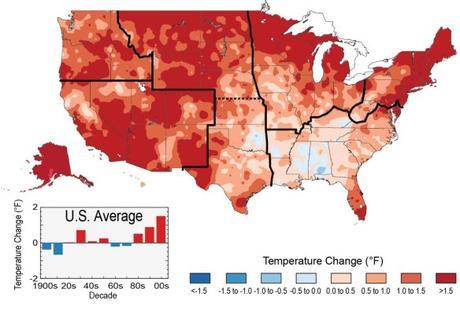Expert Global Warming Forecasts
GR: This reference covers global warming forecasts that scientists have made for the years 2015, 2020, 2025, 2030, 2035, 2040, 2050, 2080, 2090, and 2100. Projections by well-known scientists and peer-reviewed publications make this a dependable resource. Reading it, you might be amazed that there has been so much doubt and so little action on global warming.

This map shows what has actually happened in the U. S. “The colors on the map show temperature changes over the past 22 years (1991-2012) compared to the 1901-1960 average for the contiguous U.S., and to the 1951-1980 average for Alaska and Hawaii. The bars on the graph show the average temperature changes by decade for 1901-2012 (relative to the 1901-1960 average). The far right bar (2000s decade) includes 2011 and 2012. The period from 2001 to 2012 was warmer than any previous decade in every region.” (U.S. Global Change Research Program)
The following is from the Global Warming Forecasts website.
“Global warming forecasts trace their history back to the works of Swedish chemist Svante Arrhenius (1890s), American geologist Thomas Chamberlain (1890s) and British engineer Guy S. Callendar (1930s and ’40s).
“In the 1950s, after oceanographers Roger Revelle and Hans Suess published research findings concluding that “human beings are now carrying out a large-scale geophysical experiment” by discharging greenhouse gases into the atmosphere, Revelle, director of the Scripps Institution of Oceanography, recruited geochemist Charles David Keeling to begin the process of taking long-term measurements of carbon dioxide (CO2) concentrations in the atmosphere.
“When Keeling started taking CO2 measurements at the weather observatory at the top of the Mauna Loa volcano in Hawaii and on the continent of Antarctica, he established the baseline for collecting the data that would begin the modern era of global warming forecasting.
“Since Revelle’s and Keeling’s landmark work in the 1950s, global warming forecast research has expanded to develop projections based on concentrations of other greenhouse gases such as methane (the principal component of natural gas), carbon monoxide and nitrous oxide as well as temperature data, precipitation, weather patterns and specific ecosystems.
“Global warming forecasting and research formats, however, have tended to be linear or vertical in nature, i.e., focusing on observations of singular data sets over time such as:
[GR: These links take you to some excellent articles.]
- Carbon dioxide concentrations,
- Temperature trends,
- Wildfire frequency,
- Heat wave frequency,
- Water scarcity and water stress,
- Polar ice thickness,
- Permafrost melt rates,
- Arctic sea ice melt rates,
- Snowpack levels,
- Snow melt,
- Sea level rise rates, or
- Frequency and severity of floods and hurricanes.
“Similarly, projections of climate change impacts have tended to focus on specific sectors such as water resources, energy supplies, energy usage, transportation, human health, food, specific ecosystems, geographic regions, countries and continents.
“Here and on the pages that follow is a look at global warming forecasts from a “confluence forecast” or “convergence forecast” perspective. Rather than the conventional vertical format, we look at multiple converging forecasts presented in a horizontal or more integrated “side-by-side” context.” — http://www.global-warming-forecasts.com/

